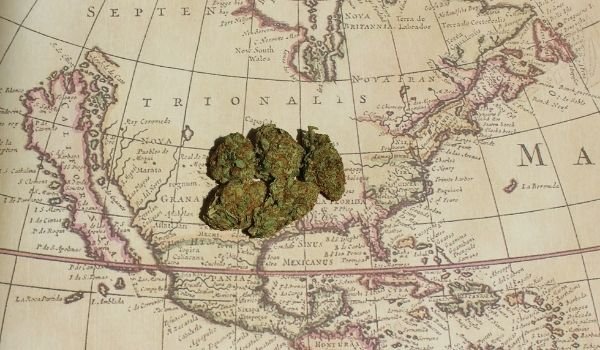Just as the plant has evolved, so too have cannabis consumption methods — and the associated consumer technologies.
Twenty-eight million years. That’s how old cannabis is. But of course, this ancient ancestor from millions of years ago looked much different than the strains we see on dispensary shelves today.

Take one look at the industry in 2022 and it’s clear that technology has dramatically shifted the cannabis landscape. What’s more, we don’t need to look back into ancient history to see these changes. Our consumption habits are incredibly different from even 20 or 30 years ago.
Extraction and consumption technology has transformed this plant’s potency, profile, and effects. Here, we take a historical look at how technology has fueled changes in consumption methods, starting with ancient civilizations dating back 4000 years.
THE OLDEST EVIDENCE OF CANNABIS USE BY HUMANS
The oldest archeological evidence of cannabis use by humans comes from a historic village called Pan-p’o in China. Dated to be 4000 years old, this evidence suggests these ancient people relied on cannabis for its fiber instead of its psychedelic or medicinal properties.
The oldest signs of cannabis ingestion or inhalation come from the fifth century BCE, China. Archeologists discovered carbonized hemp seeds, thought to have been burned as part of a funeral ritual.
According to a recent review of these ancient hemp seeds, “The chemical analysis reveals ancient cannabis burning and suggests high levels of psychoactive chemicals, indicating that people may have been cultivating cannabis and possibly actively selecting for stronger specimens or choosing plant populations with naturally high terpenophenolic secondary metabolites.”
Interestingly, these cannabis-consuming cultures didn’t use pipes or what we would today call, bongs. Instead, they placed cannabis into bowls over hot coals and burned it inside an enclosure, like a tent. Essentially, it was an ancient form of hotboxing.
There is no record of smoking implements like pipes or bongs across Eurasia and Africa until Columbus’s journey to the New World. This strongly suggests pipes, and therefore our traditional understanding of cannabis consumption was inspired by technology adopted from tobacco-smoking cultures of North and South America.
TRADITIONAL METHODS OF CANNABIS CONSUMPTION
In the Modern Era (from the Middle Ages onward), people began consuming cannabis in more familiar ways, including with pipes or processed into hash and later into tinctures. During this era, cannabis cultivation proliferated, and hashish production evolved across Asia.
Perhaps the first cannabis concentrates, hash was produced by hand in the mountainous areas of Afghanistan, Pakistan, and India. In some regions of India, hash is still an integral aspect of religious ceremonies, served in a drink known as Bhang.
.jpeg)
By thesandiegomuseumofartcollection – Flickr, Public Domain, https://commons.wikimedia.org/w/index.php?curid=38309190
The development of hashish meant that cannabis was much more portable and shelf-stable. As a result, it easily made its way along trade routes and eventually ended up used for medicinal purposes across Northern Africa and Europe.
By the 19th and 20th centuries, cannabis tinctures also came into play. Influential physicians of the time, such as J. Russel Reynolds, described preparing these tinctures to treat facial neuralgia, migraine, dysmenorrhea, gout, teething, and other painful conditions.
But, by the mid 20th century, more than 2000 years after the first evidence of human consumption, we were still stuck with essentially the same routes of administration. That meant that, during the 1960s, most people were smoking either dried plant material or hash or consuming as a single drink or tincture.
CANNABIS CONSUMPTION IN THE 21ST CENTURY
Today, technological innovation spawned by increasing legality and scientific advances has led to an explosion of product development. New products like shatters, tinctures, and even nanoemulsions mean new possibilities for consumption.
While smoking a joint remains one of the most popular methods to this day, most markets now cater to people who enjoy vaporizing, dabbing, eating, drinking, and more.
Vaporizer Technology
Most vaporizers come in the form of a vape pen. These are single-use or rechargeable, battery-powered devices that heat cannabis concentrate to the point of vaporization. So instead of burning flower and inhaling the intoxicating smoke, we now inhale intoxicating vapors.
Vaporizers also come in high-tech gadgets like the PAX or DaVinci handheld devices, which allow consumers to set specific temperatures to curate each session. Each session also integrates into a mobile app, providing recommendations and measuring effectiveness.
Dab Technology
Dabbing is a quasi vape, quasi smoke consumption method that exclusively uses highly potent concentrates like distillate, sugars, shatters, and waxes. Compared with smoking from a pipe, the dab rig is a highly complex and personalized tool for ‘dabbing’ concentrates into a chamber for inhalation.
Dabbing may be a relatively new invention; however, it’s already getting the high-tech treatment. There are now electronic nails, eliminating the need for butane torches. There are dab temperature readers like the Octave and the Terpometer, which regulate nail temperatures.
Edible Technology
For consumers who prefer to avoid inhaling their medicine, the edible market has come a long way from the days of homemade magic brownies. Infusion technologies have revolutionized the cannabis kitchen. Edibles in the commercial market have evolved from using full-spectrum oils to using water-soluble isolates and back to full-spectrum rosins.
Several small appliances now serve the home chef in creating all manner of edibles. Brands like Ardent, LEVO, and Magical Butter make cannabutter (among other infusions) simple, precise, and consistent — all things which have traditionally eluded cannabis cooks.
CANNABIS CONSUMPTION DRIVEN BY TECH
Consumer cannabis consumption habits today are driven by technology. The ritual of smoking dried flower will likely never truly disappear, but increasingly consumers are seeking stronger, more consistent, and predictable experiences.
Technologies like the OCTAVE, the LEVO, and the DaVinci are helping to solve the longstanding issues consumers have had with the ever-variable natural flower. This means precision temperatures to target specific cannabinoids, perfect edible infusions, and more.
The future of these consumer technologies will continue to solve the natural variability of the plant and resolve the health risks posed by smoking and rudimentary forms of vaping.

